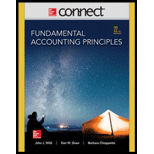
Concept explainers
Concept Introduction:
Perpetual Inventory System: The perpetual inventory system records and updates the inventory after each and every transaction. The inventory balance is updated after each transaction and it is kept up to date at every time.
Methods of
• Specific identification method: Under this method the cost of goods sold and ending inventory units are identifiable and the cost is calculated accurately for each unit sold and in the inventory.
• Weighted Average method: Under this method, the cost per unit of the inventory is calculated as weighted average cost per unit and the cost of goods sold and inventory is calculated with the help of weighted average cost per unit.
• FIFO method: FIFO Stands for First In First Out. Under this method, the units purchased first are assumed to be sold first and cost of goods sold is calculated accordingly. The ending inventory in the method includes the latest units purchased.
• LIFO method: LIFO Stands for Last In First Out. Under this method, the latest units purchased are assumed to be sold first and cost of goods sold is calculated accordingly. The ending inventory in the method includes the oldest units purchased.
Requirement (a):
To determine: Cost of ending inventory and Cost of goods sold using the Specific identification method.
Requirement (b):
To determine: Cost of ending inventory and Cost of goods sold using the perpetual inventory weighted average method.
Requirement (c):
To determine: Cost of ending inventory and Cost of goods sold using the perpetual inventory FIFO method.
Requirement (d):
To determine: Cost of ending inventory and Cost of goods sold using the perpetual inventory LIFO method.
Want to see the full answer?
Check out a sample textbook solution
Chapter 6 Solutions
FUND.ACCT.PRIN -ONLINE ONLY >I<
- I am trying to find the accurate solution to this financial accounting problem with appropriate explanations.arrow_forwardI need the correct answer to this financial accounting problem using the standard accounting approach.arrow_forwardPlease help me solve this general accounting question using the right accounting principles.arrow_forward
- Nonearrow_forwardLawson Corporation lists fixed assets of $250 on its balance sheet. The firm's fixed assets have recently been appraised at $390. The firm's balance sheet also lists current assets at $85. Current assets were appraised at $97.5. Current liabilities book and market values stand at $72 and the firm's long-term debt is $165. Calculate the market value of the firm's stockholder's equity. a. $104.50 b. $244.5 c. $250.5 d. $128.30 provide answerarrow_forwardLumen Products, which uses the high-low method, had total costs of $32,000 at its lowest level of activity when 6,000 units were sold. At its highest level of activity, total costs were $50,000 when 11,000 units were sold. Lumen would estimate fixed costs as _. Need Answerarrow_forward
- I need help with this general accounting problem using proper accounting guidelines.arrow_forwardA company paid $36,000 for a 3-year insurance policy on January 1, 2024. The payment was recorded as a prepaid expense. What is the adjusting entry required on December 31, 2024?arrow_forwardDirect materials used totaled $78,320; direct labor incurred totaled $215,640; manufacturing overhead totaled $298,750; Work in Process Inventory on January 1, 2023, was $157,830; and Work in Process Inventory on December 31, 2023, was $142,940. What is the cost of goods manufactured for the year ended December 31, 2023?arrow_forward

 AccountingAccountingISBN:9781337272094Author:WARREN, Carl S., Reeve, James M., Duchac, Jonathan E.Publisher:Cengage Learning,
AccountingAccountingISBN:9781337272094Author:WARREN, Carl S., Reeve, James M., Duchac, Jonathan E.Publisher:Cengage Learning, Accounting Information SystemsAccountingISBN:9781337619202Author:Hall, James A.Publisher:Cengage Learning,
Accounting Information SystemsAccountingISBN:9781337619202Author:Hall, James A.Publisher:Cengage Learning, Horngren's Cost Accounting: A Managerial Emphasis...AccountingISBN:9780134475585Author:Srikant M. Datar, Madhav V. RajanPublisher:PEARSON
Horngren's Cost Accounting: A Managerial Emphasis...AccountingISBN:9780134475585Author:Srikant M. Datar, Madhav V. RajanPublisher:PEARSON Intermediate AccountingAccountingISBN:9781259722660Author:J. David Spiceland, Mark W. Nelson, Wayne M ThomasPublisher:McGraw-Hill Education
Intermediate AccountingAccountingISBN:9781259722660Author:J. David Spiceland, Mark W. Nelson, Wayne M ThomasPublisher:McGraw-Hill Education Financial and Managerial AccountingAccountingISBN:9781259726705Author:John J Wild, Ken W. Shaw, Barbara Chiappetta Fundamental Accounting PrinciplesPublisher:McGraw-Hill Education
Financial and Managerial AccountingAccountingISBN:9781259726705Author:John J Wild, Ken W. Shaw, Barbara Chiappetta Fundamental Accounting PrinciplesPublisher:McGraw-Hill Education





